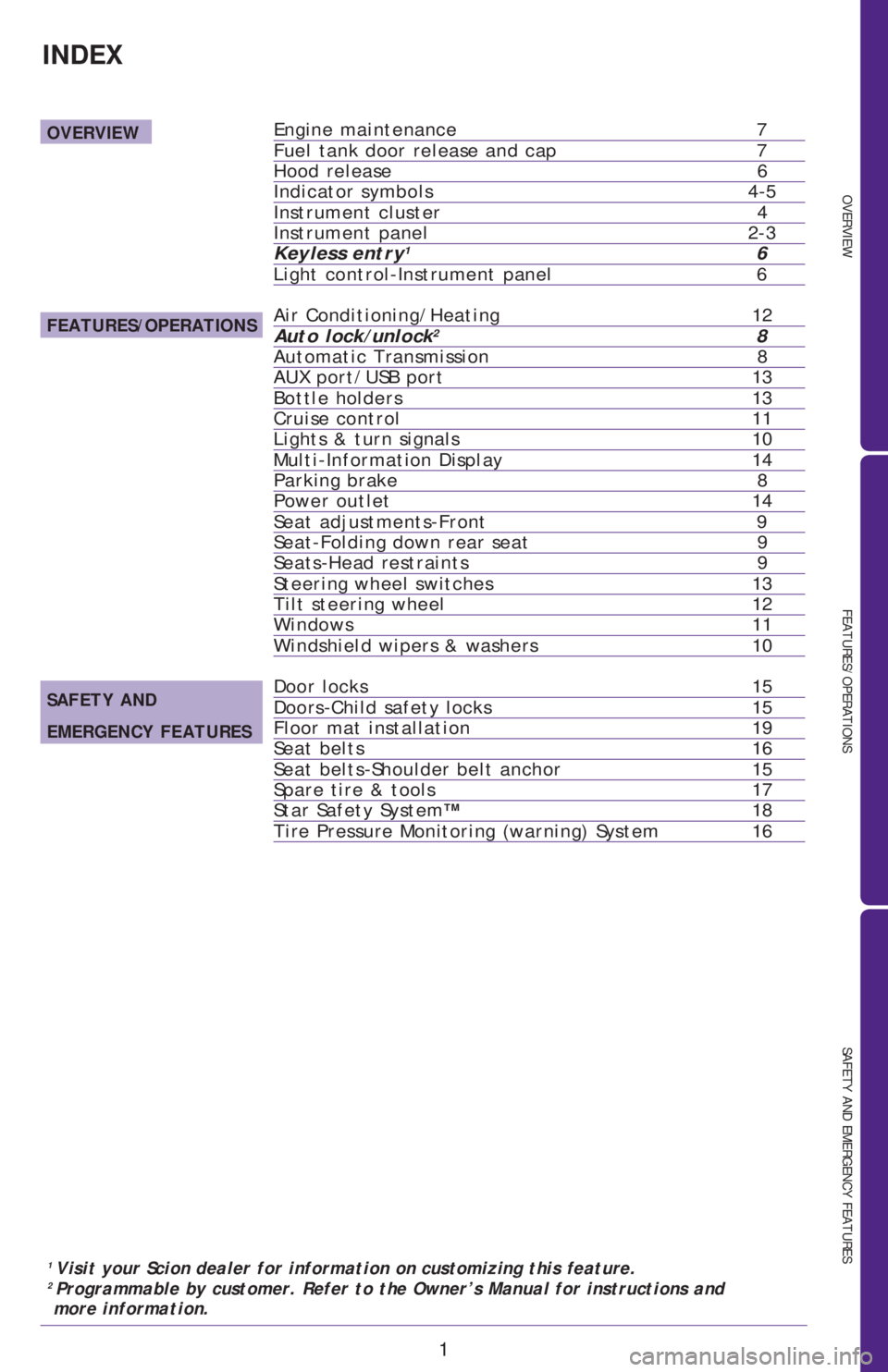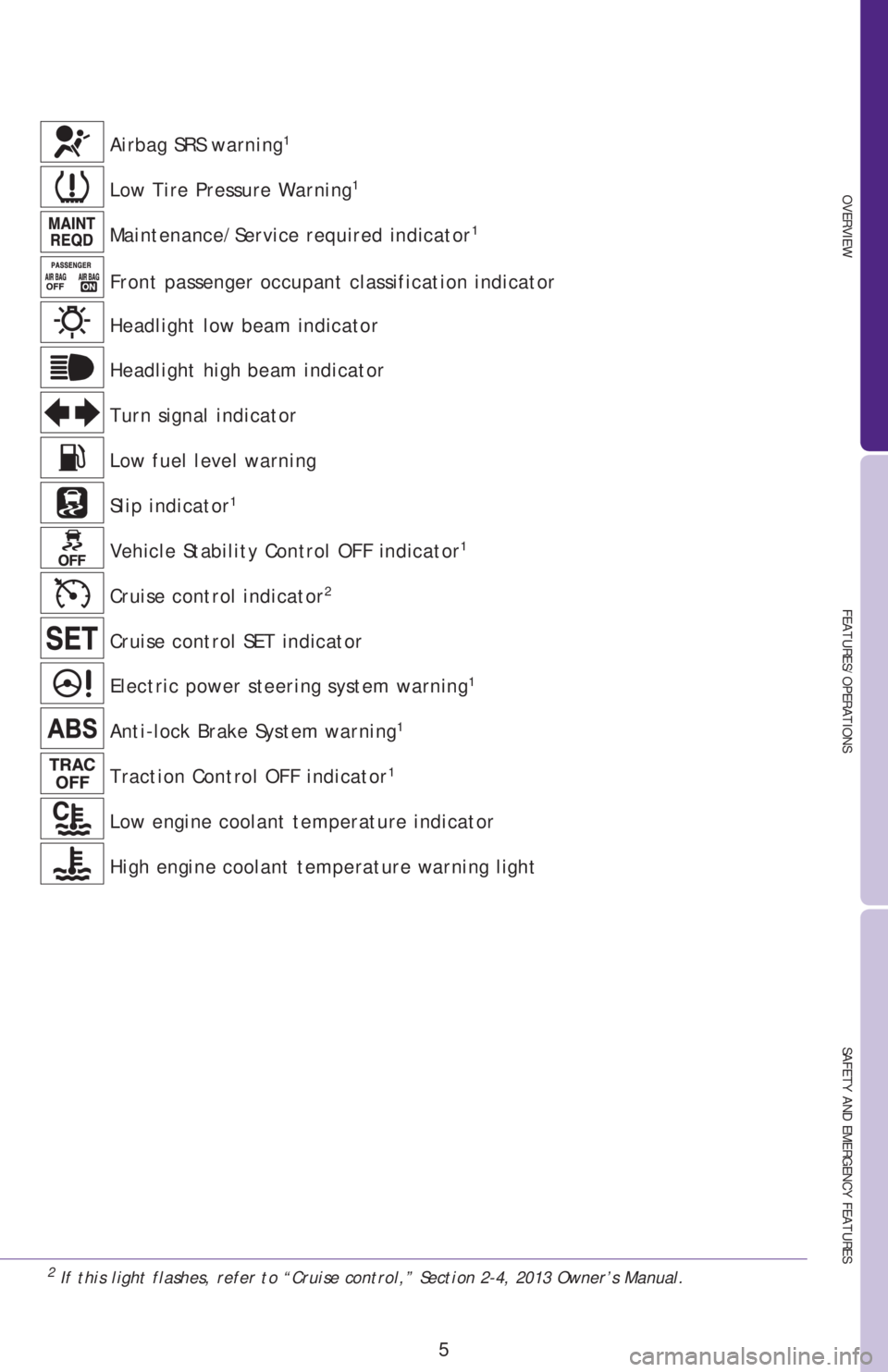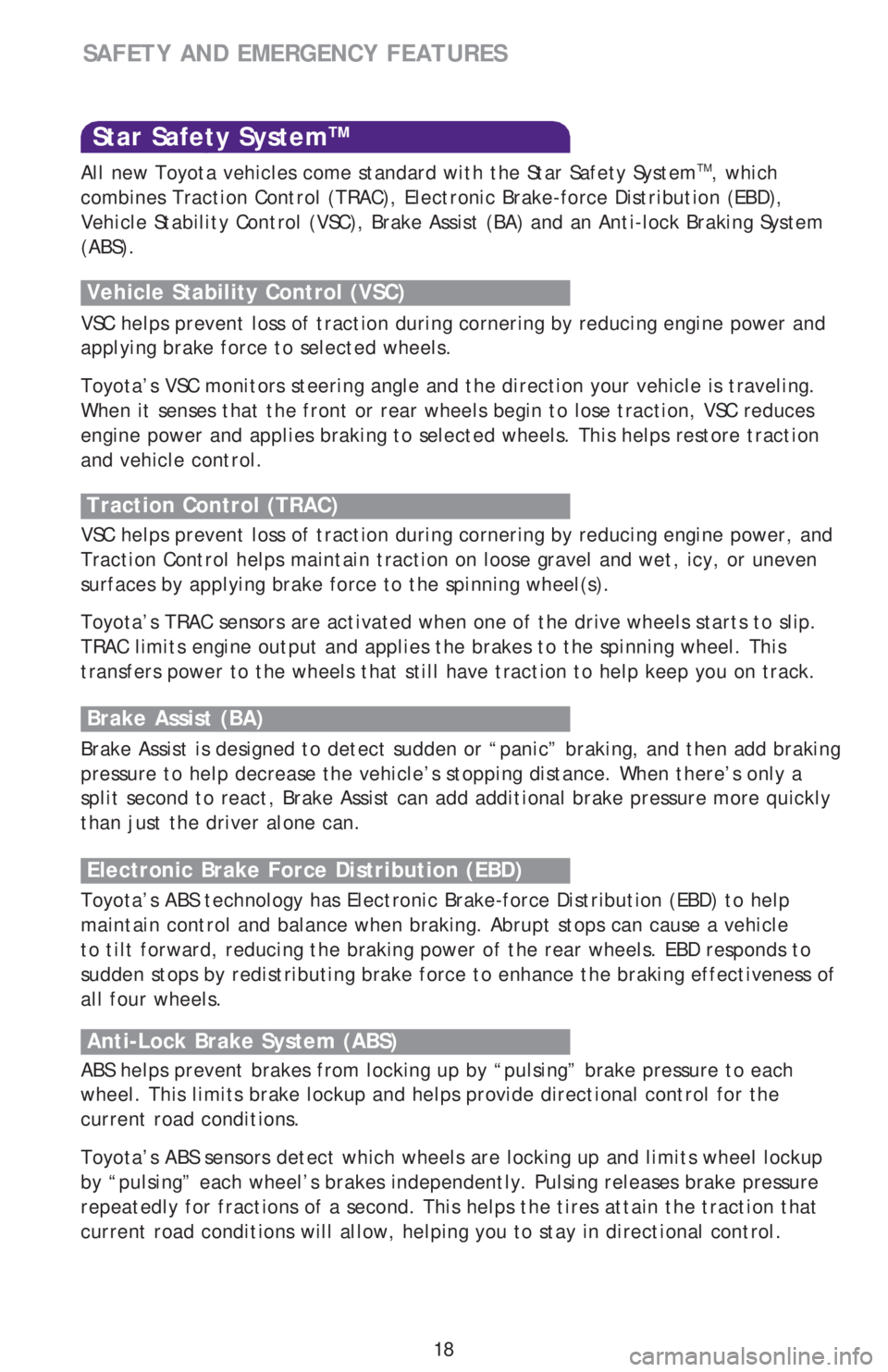brake TOYOTA xB 2013 Owners Manual (in English)
[x] Cancel search | Manufacturer: TOYOTA, Model Year: 2013, Model line: xB, Model: TOYOTA xB 2013Pages: 24, PDF Size: 1.52 MB
Page 3 of 24

OVERVIEW
FEATURES/OPERATIONS
SAFETY AND EMERGENCY FEATURES
1
INDEX
OVERVIEW
FEATURES/OPERATIONS
SAFETY AND
EMERGENCY FEATURES
Engine maintenance 7
Fuel tank door release and cap 7
Hood release 6
Indicator symbols 4-5
Instrument cluster 4
Instrument panel 2-3
Keyless entry
1 6
Light control-Instrument panel 6
Air Conditioning/Heating 12
Auto lock/unlock
2 8
Automatic Transmission 8
AUX port/USB port 13
Bottle holders 13
Cruise control 11
Lights & turn signals 10
Multi-Information Display 14
Parking brake 8
Power outlet 14
Seat adjustments-Front 9
Seat-Folding down rear seat 9
Seats-Head restraints 9
Steering wheel switches 13
Tilt steering wheel 12
Windows 11
Windshield wipers & washers 10
Door locks 15
Doors-Child safety locks 15
Floor mat installation 19
Seat belts 16
Seat belts-Shoulder belt anchor 15
Spare tire & tools 17
Star Safety System
TM 18
Tire Pressure Monitoring (warning) System 16
1 Visit your Scion dealer for information on customizing this feature.2 Programmable by customer. Refer to the Owner’s Manual for instructions and
more information.
Page 6 of 24

4
OVERVIEW
Low engine oil pressure warning1
Driver seat belt reminder
(alarm will sound if speed is over 12 mph)
Front passenger seat belt reminder
(alarm will sound if speed is over 12 mph) Brake system warning
1
Charging system warning1
Malfunction/Check Engine indicator1
Indicator symbols
Open door warning
Instrument cluster
Service indicator and reminder
Speedometer
Tachometer
Fuel gauge
Clock
Outside temperature
Clock button
Odometer and two trip meters
Odometer/trip meter and trip meter reset button
Multi-Information Display
Multi-Information Display control switch
Automatic Transmission shift position indicator (if equipped)
1
If indicator does not turn off within a few seconds of starting engine, there may be a
malfunction. Have vehicle inspected by your Toyota dealer.
For details, refer to “Indicators and warning lights,” Section 2-2, 2013 Owner’s
Manual.
Page 7 of 24

OVERVIEW
FEATURES/OPERATIONS
SAFETY AND EMERGENCY FEATURES
5
Anti-lock Brake System warning1
Low Tire Pressure Warning1
Maintenance/Service required indicator1
Headlight low beam indicator
Turn signal indicator Headlight high beam indicator
Cruise control indicator
2
Electric power steering system warning1
Slip indicator1
Vehicle Stability Control OFF indicator1
Airbag SRS warning1
Low fuel level warning Front passenger occupant classification indicator
High engine coolant temperature warning light Traction Control OFF indicator
1
Low engine coolant temperature indicator
Cruise control SET indicator
2 If this light flashes, refer to “Cruise control,” Section 2-4, 2013 Owner’s Manual.
Page 10 of 24

* The ignition switch must be “ON” and the brake pedal depressed to shift
from Park.
Push shift lever to the left from “D” position.
+: Upshift (push and release)
-: Downshift (pull and release)
Downshifting increases power going uphill, or provides engine braking downhill.
For best fuel economy during normal driving conditions, always drive with the shift
lever in the “D” position.
8
FEATURES/OPERATIONS
Auto lock/unlock
Automatic door locks can be programmed to operate in four different modes, or
turned OFF.
-Doors lock when shifting from Park.
1
-Doors lock when the vehicle speed goes above approximately 12 mph.2
-Doors unlock when ignition key is turned to “ACC” or “LOCK” position and
driver’s door is opened.2
-Doors unlock when shifting into Park.1
1
Automatic Transmission only2 Default setting is off
Refer to the Owner’s Manual for more details.
Automatic Transmission (if equipped)
“S” (Sequential) mode
Parking brake
Pull(2) Push(1) Pull slightly
(3) Lower
Set Release
Park*
Reverse
Neutral
Drive
P
R
N
D
N
S“S” mode“S”
“D”
+ (“S” mode)
- (“S” mode)
Page 13 of 24

OVERVIEW
FEATURES/OPERATIONS
SAFETY AND EMERGENCY FEATURES
11
Windows
Automatic operation (driver’s window only) Push the switch completely down
and release to fully open. To stop the window partway, operate the switch in the
opposite direction.
Window lock switch Deactivates all passenger windows. Driver’s window remains
operable.
Up
Down
Driver side
Window lock switch
Cruise control
1 The set speed may also be cancelled by depressing the brake pedal or the clutch
pedal (manual transmission only).
2 The set speed may be resumed once vehicle speed reaches approximately 25 mph.
System ON/OFF
Functions
System ON/OFF
Resume
2/Increase speed
Set/Decrease speed
Cancel1
Page 20 of 24

18
Star Safety SystemTM
VSC helps prevent loss of traction during cornering by reducing engine power and
applying brake force to selected wheels.
Toyota’s VSC monitors steering angle and the direction your vehicle is traveling.
When it senses that the front or rear wheels begin to lose traction, VSC reduces
engine power and applies braking to selected wheels. This helps restore traction
and vehicle control.
Vehicle Stability Control (VSC)
Anti-Lock Brake System (ABS)
Brake Assist (BA)
ABS helps prevent brakes from locking up by “pulsing” brake pressure to each
wheel. This limits brake lockup and helps provide directional control for the
current road conditions.
Toyota’s ABS sensors detect which wheels are locking up and limits wheel lockup
by “pulsing” each wheel’s brakes independently. Pulsing releases brake pressure
repeatedly for fractions of a second. This helps the tires attain the traction that
current road conditions will allow, helping you to stay in directional control. Brake Assist is designed to detect sudden or “panic” braking, and then add braking
pressure to help decrease the vehicle’s stopping distance. When there’s only a
split second to react, Brake Assist can add additional brake pressure more quickly
than just the driver alone can. VSC helps prevent loss of traction during cornering by reducing engine power, and
Traction Control helps maintain traction on loose gravel and wet, icy, or uneven
surfaces by applying brake force to the spinning wheel(s).
Toyota’s TRAC sensors are activated when one of the drive wheels starts to slip.
TRAC limits engine output and applies the brakes to the spinning wheel. This
transfers power to the wheels that still have traction to help keep you on track.
Traction Control (TRAC)
Electronic Brake Force Distribution (EBD)
Toyota’s ABS technology has Electronic Brake-force Distribution (EBD) to help
maintain control and balance when braking. Abrupt stops can cause a vehicle
to tilt forward, reducing the braking power of the rear wheels. EBD responds to
sudden stops by redistributing brake force to enhance the braking effectiveness of
all four wheels.
SAFETY AND EMERGENCY FEATURES
All new Toyota vehicles come standard with the Star Safety SystemTM, which
combines Traction Control (TRAC), Electronic Brake-force Distribution (EBD),
Vehicle Stability Control (VSC), Brake Assist (BA) and an Anti-lock Braking System
(ABS).